Let’s get ready to RUMMMMBLLLLLLEEEEEE!! No. There’s not going to be a dramatic knockdown or drag-out on this one. Just a good, old-fashioned comparison of two great films. I will say, both Edmund Goulding (1947) and Guillermo del Toro (2021) have taken William Lindsay Greshams’ 1946 book “Nightmare Alley” and created two mesmerizing films that both immediately pull you in so deeply that you feel yourself becoming one with the carnival. You almost start to feel like a spectator or employee watching the sideshow geek in his horrific first scene. Both versions are similar in their initial presentation of the book.

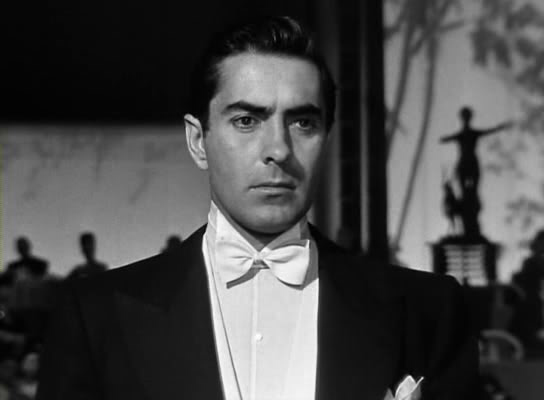 (1947) Stan, Tyrone Power
(1947) Stan, Tyrone Power
Stan Carlisle is ambitious, ruthless, self-absorbed, and devilishly handsome. Both directors have chosen remarkable, good-looking stars as their lead characters. In the 1947 version, no one would’ve missed a chance to see Tyrone Power in his latest film, tall, romantically handsome, and very talented. (he was 5’10’, considered tall for the time, and a double row of eyelashes framing smoldering eyes. They could speak his lines for him, without him saying a word.) He was not only talented but considered a self-sacrificing war hero. He walked away from Hollywood at one point to join WWII as a transport pilot. (He was responsible for the evacuation of wounded marines from Iwo Jima and Okinawa, where he also saw combat.) (flyingfeathersnecks.org)
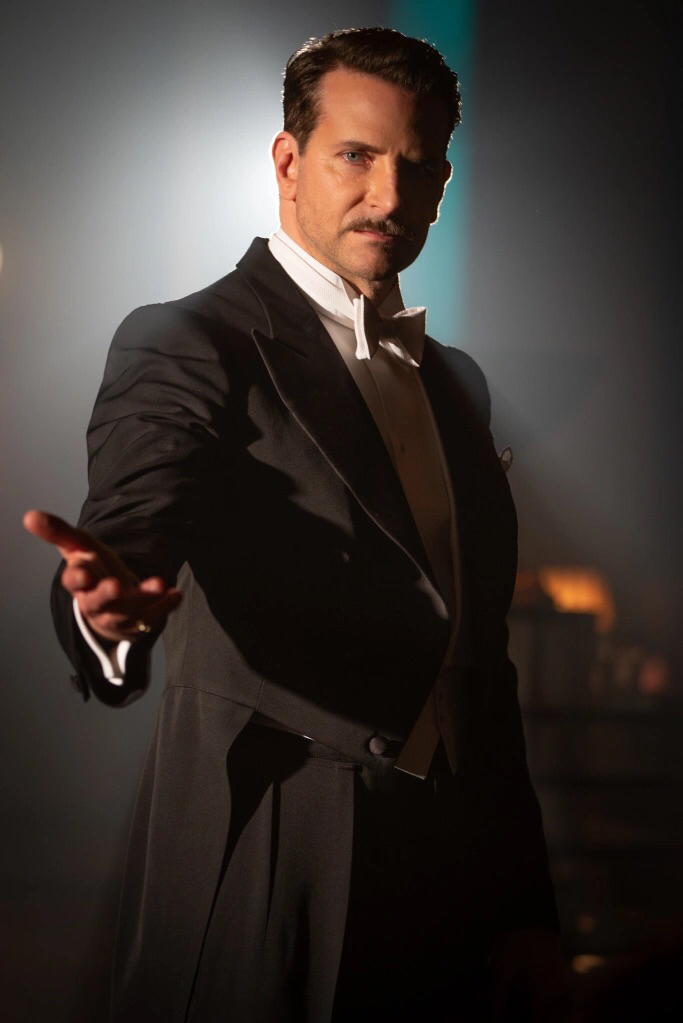
(2021) Stan, Bradley Cooper
Now you’d be hard-pressed today to find another actor as good-looking as Bradley Cooper or as talented. He’s one of the most versatile performers in film today. From comedy (The Hangover) to drama (American Sniper) he’s done pretty much everything in between. He has proven his talent beyond measure. In Nightmare Alley he IS Stan Carlisle. And he can become one with, effortlessly moving from one character to another completely as though the character was written for him. (I should mention that I’m looking forward to seeing him transform himself into Leonard Bernstein in the “Maestro”) In all fairness to Mr. Cooper, we must mention he is also tall (6’1 or 6’2’), with piercing blue eyes.
Both Mr. Power and Mr. Cooper become the main character but in different ways. As do most of the cast in Nightmare Alley. This was not done entirely by choice, Hollywood was producing films under the guidance of the Hays Code, which was a form of self-censorship of the movie content. Its more commonly known as the motion picture production code. The Hays Code was implemented from the years 1934 to 1968. For this time frame, it was considered a moral safeguard against what would be considered lewd actions or dialogue. This code would have saved a film from being sliced and diced during the editing process. So, Goulding had a bit more restrictive rules on his creativity. And leaves us to wonder how different his film version would have been, had it not been implemented.
I believe we can see clearly and compare each film honestly, as two genius directors have brought this remarkable story to life. So, for easier comparisons, I will refer to the versions like 1947 or 2021. During this comparison, we will see how the code restrictions against profanity, nudity, graphic or realistic violence, sexual persuasions, and rape played an integral part in bringing two pictures with the same interpretation to the screen, and yet made the audience experience so varied.
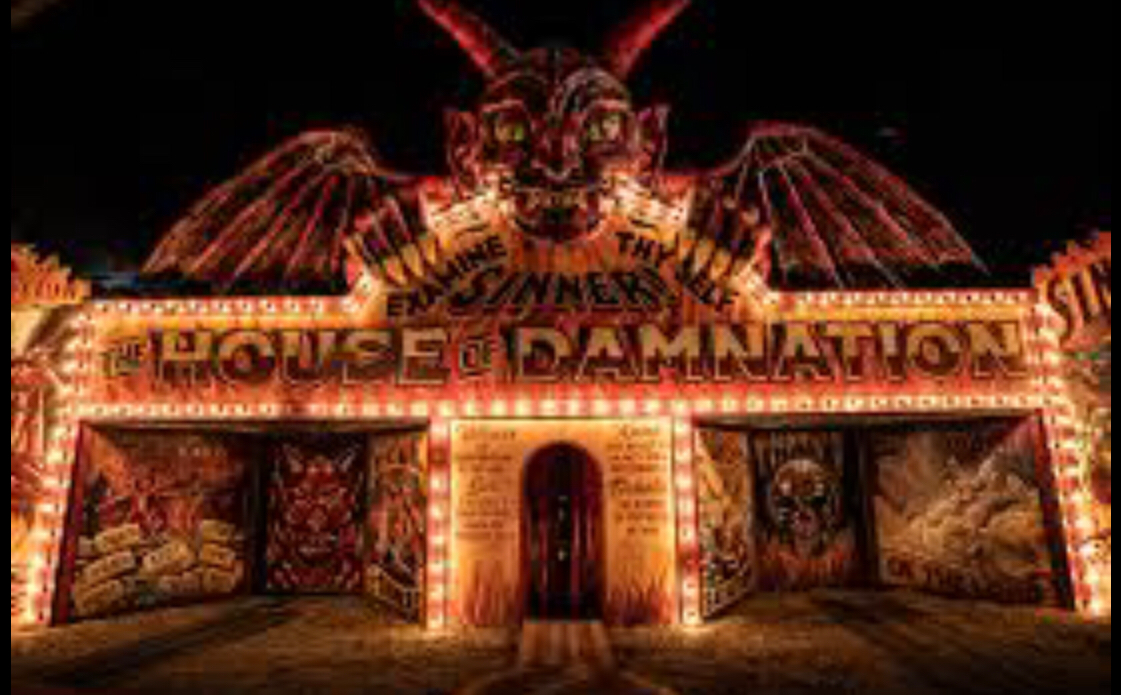 (2021) House of Damnation
(2021) House of Damnation
The story begins with Stan Carlisle finding his way to the Ambersons’ Carnival. He is looking for a job and he finds one. When he begins his employment, he finds an array of characters both bizarre and normal who begin to accept him out of necessity, due to his workstation, but there is a feeling that he’s not part of the clique or family if you will.

(1947) Audience, Nightmare Alley
In 1947, you see a gradual acceptance of Stan by the carny folk. It’s Stan who keeps them at a distance, telling them he was an orphan and lived in a home. It never cleared up whether or not that is a lie or the truth.
In 2021, Stan never blends in, he chooses to be more of an outsider by his all-consuming drive for fame and money. He never divulges his past to them, even in the sketchiest terms. But we, the audience see it throughout this version in the most horrific scenes and flashbacks. His father’s death is a series of images that some may find unimaginable. (Something that Goulding would not be able to show, due to the Hays code.)
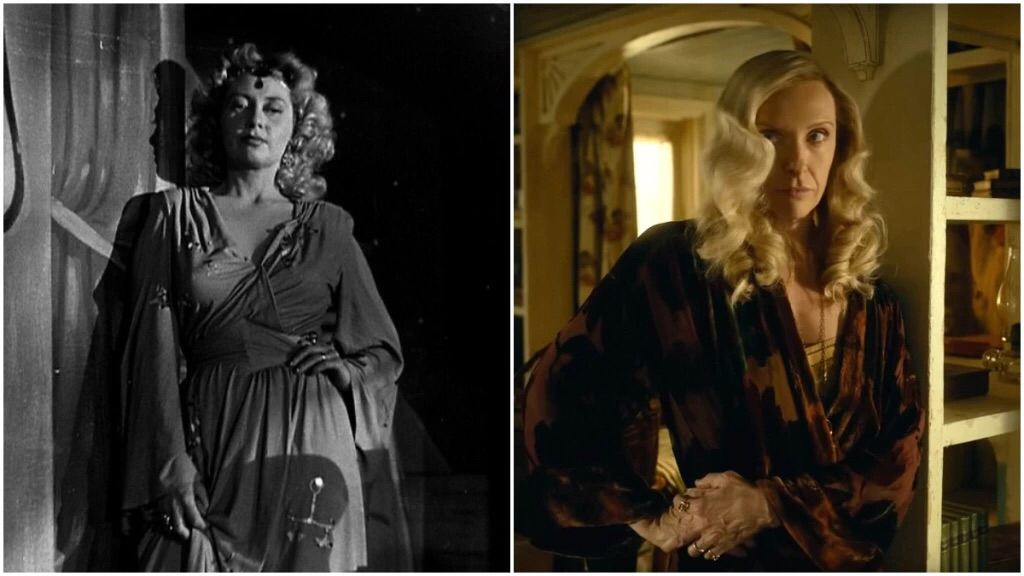 (1947) Zeena (2021)
(1947) Zeena (2021)
In both the 1947 and 2021 versions, he finds a place in the lives of Zeena and Pete. The Zeena character in both versions is a true believer in the Tarot and its power. 1947 Stan takes it seriously, but in 2021 Stan mocks the power of the cards. So, a big question becomes, did he then begin his path of destruction by mocking the dire warning the cards gave him with the Hangman’s card? A little bit of foreshadowing never hurts.
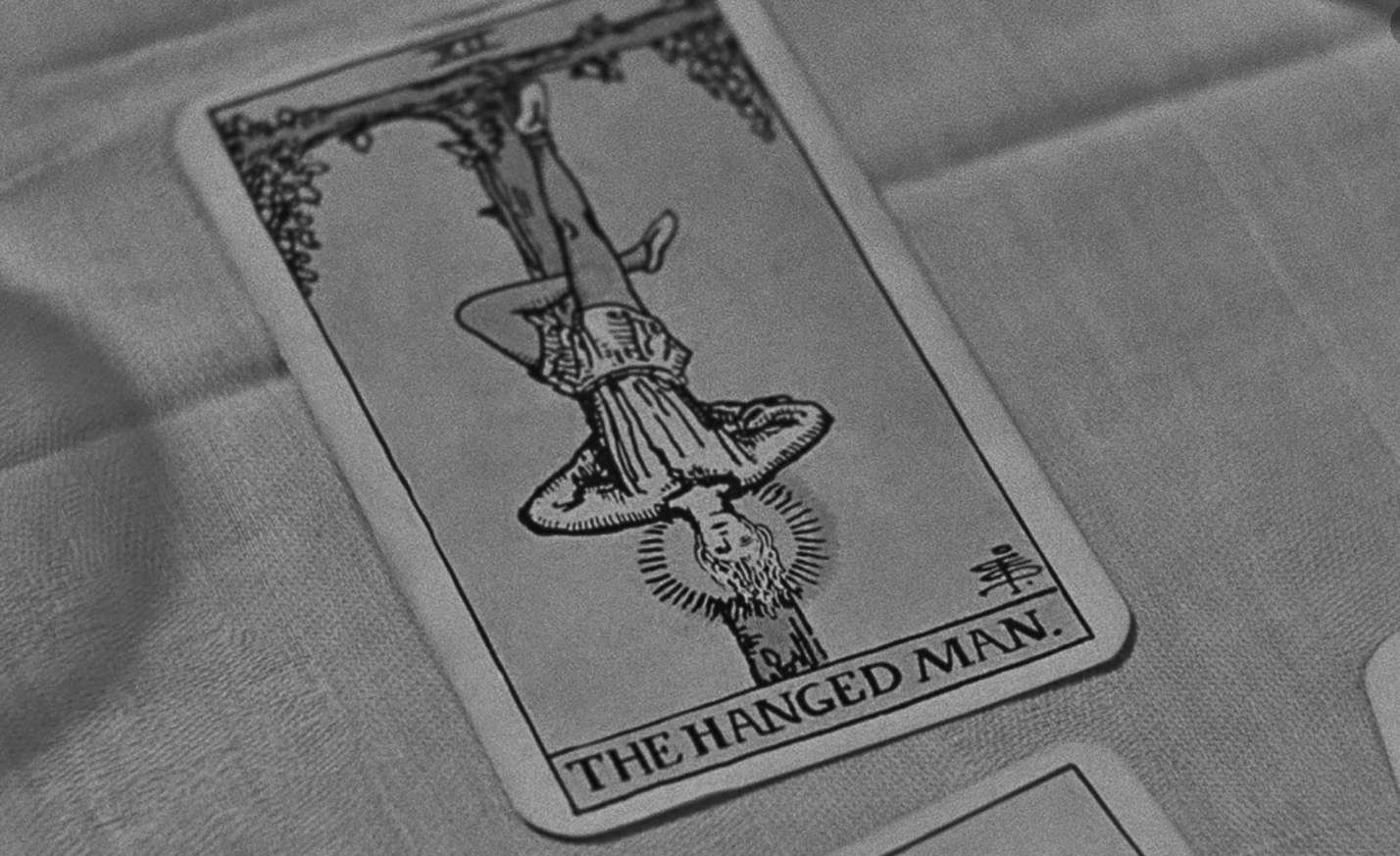 (1947) The Hanged Man.
(1947) The Hanged Man.
In both 1947 and 2021, Zeena and Stan begin a romantic interlude. 1947, keeps it clean with a kiss on the arm, a gentle touch, and some smoldering looks from Stan and his seductive eyes. In 2021, Zeena watches Stan undress and sit in a tub for a 10-cent bath he paid for to clean off the dust and grime. No long-full glances here, Zeena just reaches in the tub, below the bathwater and Stan gets the point she’s making. (So much for hints and flirting.)
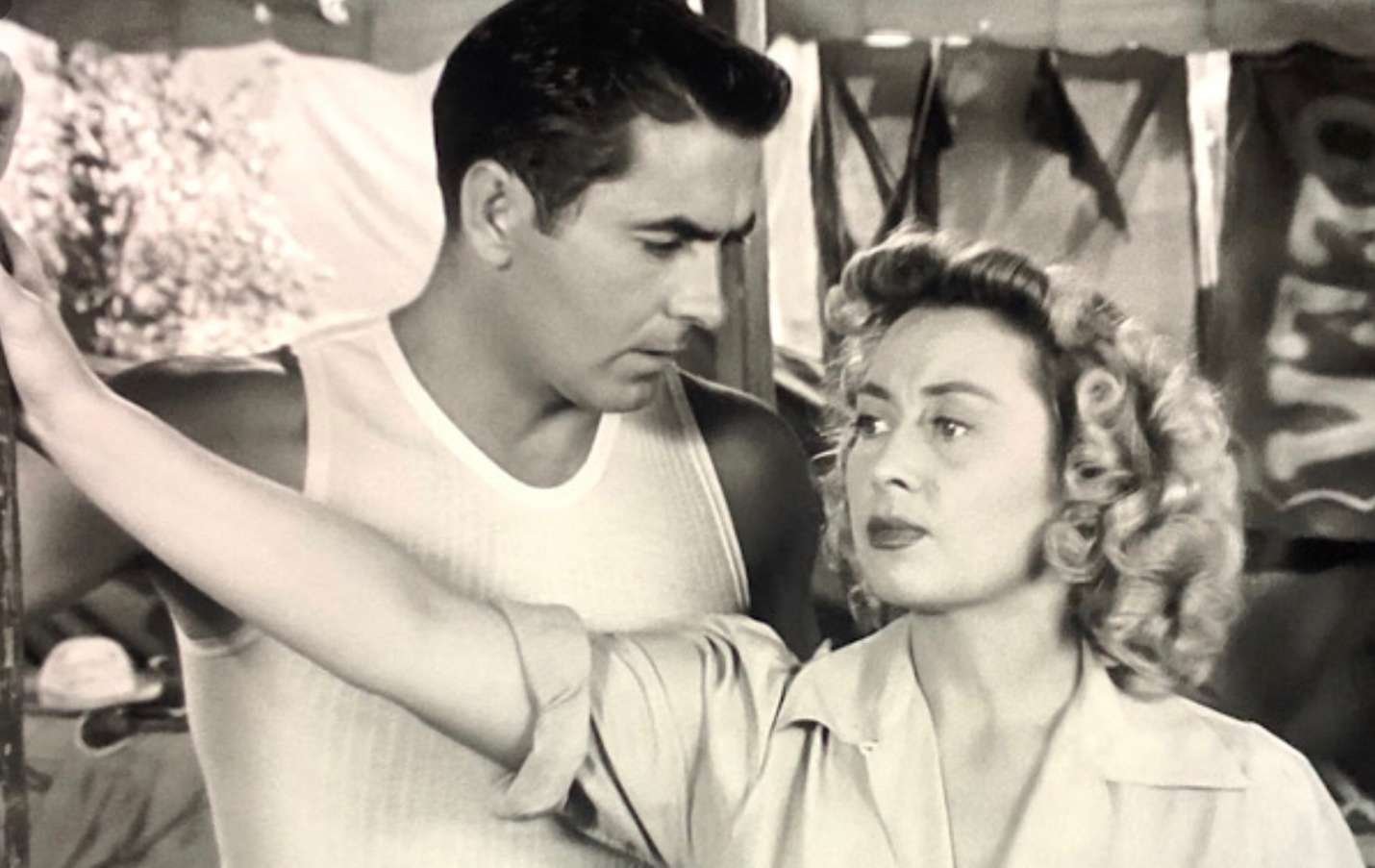
(1947) Zeena and Stan
In both versions, Stan is playing his game with the self-confidence of a foolish man. One chooses to ignore the Hangman’s warning and the other mocks it. And both continue with their plan to become famous and rich. This is when we learn about the “codebook”.
The “codebook” is a series of words that Zeena and her husband, Pete used in their mind-reading act. Which had, at one point, really brought them to the big time. It can be assumed it crumbles because Pete is a hopeless drunk. That, and the possibility that fate will not let them rise above a certain station in life. They just get a taste and it’s snatched away. Fate, you see, is a cruel mistress.
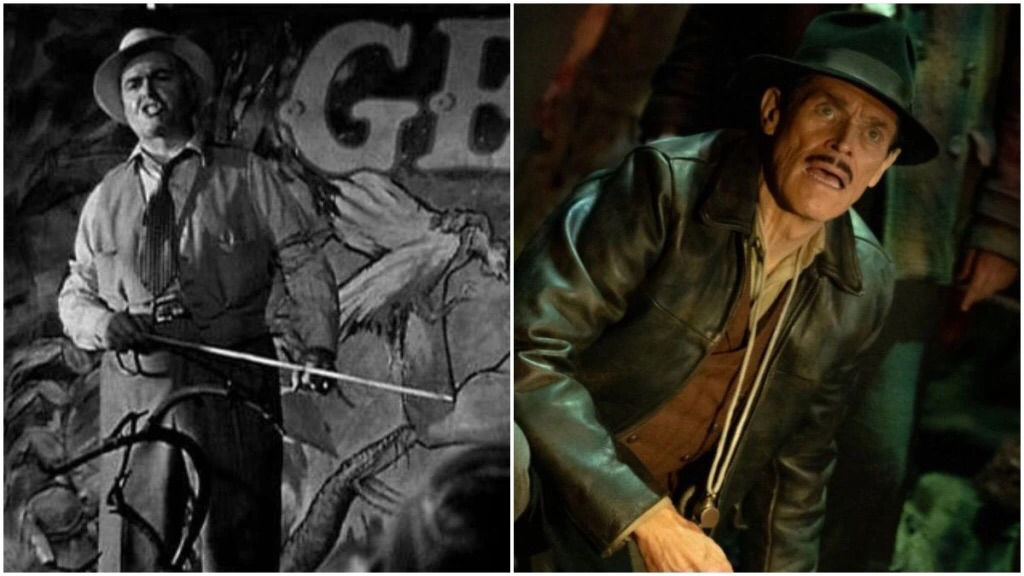
(1947) Clem (2021)
1947 Zeena and Pete are very protective of the code book. Zeena admits to Stan that she could sell it and get Pete into a treatment program for his drinking. In 2021, Zeena and Pete seem a lot more willing to explain the code to Stan. The bottom line, both versions Stans must have the codebook. And he does after Pete consumes wood grain alcohol procured by Stan and dies. Coincidence? Of course not. Both Stans are now on their way to ruin with codebook in hand.

(1947) Molly (2021)
Next, both versions explain Molly, a naïve young girl drawn into Stans’s life by a forced marriage. Shotgun weddings weren’t only implemented in the case of pregnancy, but also for the soiled virtue of a young girl. Most men complied because every father had a shotgun, shovel, and a place to hide the body. In both cases, Stan marries Molly because with her status and codebook he can make it into high society with his Mentalist act. With his charisma and confidence, he succeeds. But he has again taken another step towards his impending doom.  He’s become more reckless and arrogant, with no qualms about taking Molly with him.
He’s become more reckless and arrogant, with no qualms about taking Molly with him.
(1947) Lilith (2021)
At this point, both movies are moving on the same path. During one of his performances, he meets Lilith. With this meeting, he doesn’t realize he is now on the direct path of destruction. He’s like a person watching a volcano explode too close to the base, with magma and hot stones about to rain on his head. He’s fooled himself into believing he is controlling Lilith, but his fingers aren’t in control of the strings. They are looped tightly around hers.
In the 1947 version, Lilith is as cold and deadly as an iceberg. Most of her dangers are below the surface, she’s almost like a guard at a prison camp, with a smile like someone watching the trains pull up with prisoners in them. The 2021 Lilith is more garish. Bright and showy, but at the same time lurid. The difference between the actors/characters may be a product of the black and white film and one in color. Black and white give the viewer shadows and an element of mystery. It gives the viewer the sense that Lilith is like a marble stone in the moonlight; cold, emotionless. The color, 2021 Lilith, automatically seems dangerous, you can see the fangs  behind the blood-red lips.
behind the blood-red lips.
(1947) Mentalist Act (2021)
Both Stans are now running headfirst into an inevitable destiny, one like Zeena and Pete, they will be brought down, once again to the station in life they were born into, one they were never meant to escape. Neither of them appears to feel the slender fingers with sharp red claws on their backs. Are they arrogant, stupid, or too trusting? Whichever conclusion the audience comes to, the result will be the same. Stan will be destroyed.
At this point, both versions have Stan in control. He has fame, fortune, and, of course, Molly. He doesn’t love her but loves having her in his show. Without her part of the mind-reading act, he couldn’t succeed. So, he uses her and even convinces her that they move onto the next level of fame: The Spook Show.
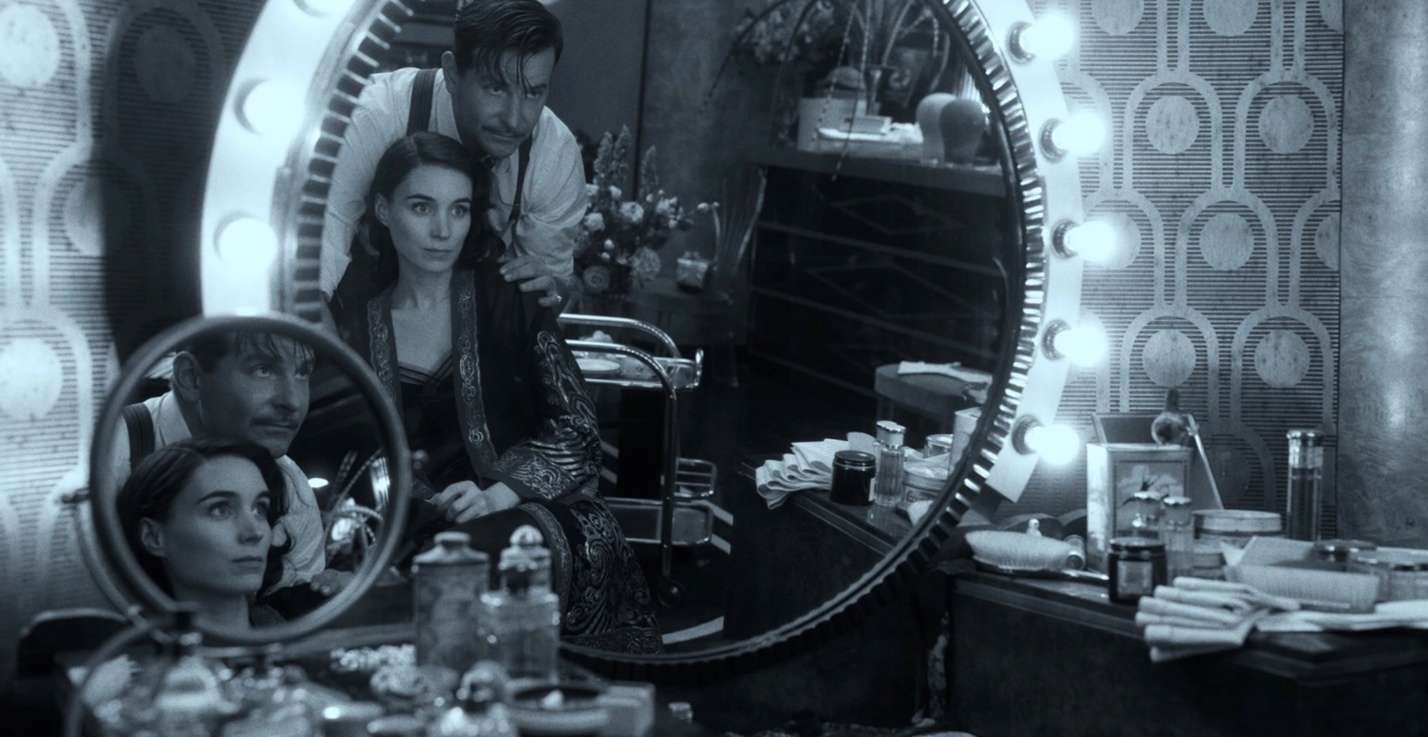
(2021) Stan and Molly
Molly has been the voice of reason and knows this is the wrong move. But she is powerless to change Stan’s mind.
On a side note, The Spook Show is about the age of spiritualism that gained popularity after WW1. Grieving parents wanted one more connection with a beloved son killed on the battlefield. There was a tragic need to not let go of the dead.
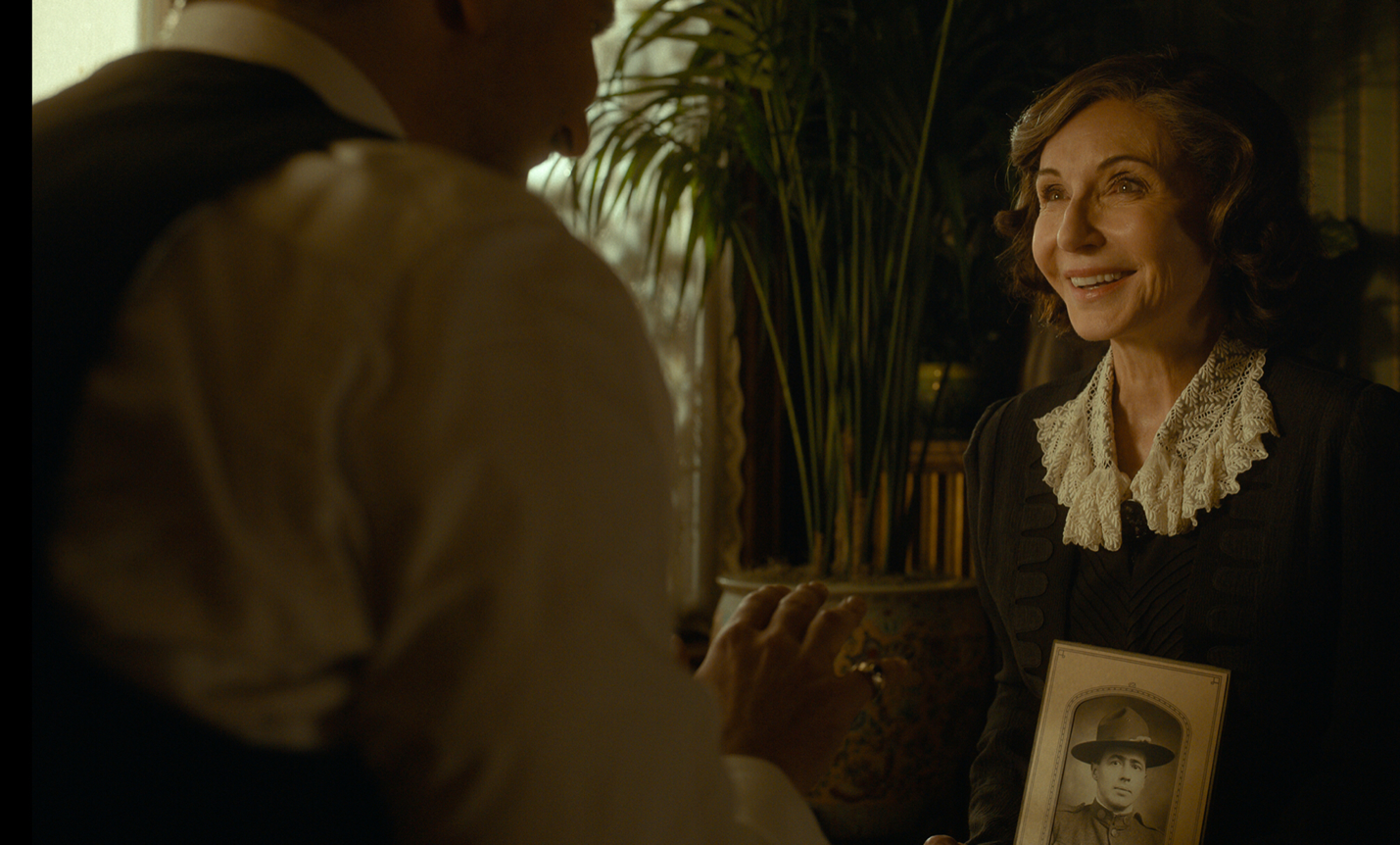
(2021) Stan and Mrs. Kimball
In both versions, Stans Spook Show leads to the murder/suicide of Judge and Mrs. Kimball. He has promised that they would reunite with their dead son, Julian. In 1947, the audience is only aware of the tragedy. In 2021, you pretty much have your face rubbed in the blood of the deceased. It’s possible that Del Torro meant for this to symbolize what Stan’s actions are doing. It is a turning point, with Molly ready to leave. Stan is becoming a cheat in both his personal and professional life. It all culminates with the meeting and murdering of Ezra Grindle, a man, who believe it or not, makes Stan look almost saintly. The 2021 version explains what Grindle has done in his lifetime: murder, abortion, and serial rape. These are things the 1947 version would not have been allowed to show, due to the Hays Code, nor do I believe the audience of the era would have wanted to see it. Sadly, the shock value of Grindle’s deeds wouldn’t even send a ripple through today’s audience. In 2021, shock value is practically nonexistent.
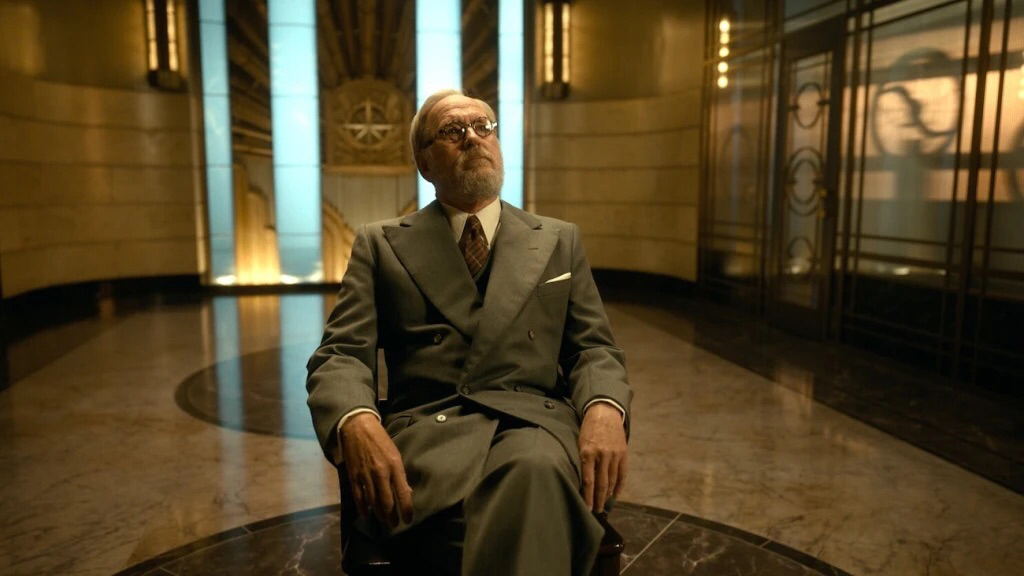
(2021) Ezra Grindle
Stan’s final confrontation with Lilith in the 2021 version turns into a knockdown, drag-out fight. He’s now realized that she has been using him the whole time. She has stolen his money and manipulated him to be her lethal instrument against Grindle by killing him after making a fool out of him. This is the catalyst for Molly to finally leave. The fight is brutal, a bullet to the ear, near strangulation with a telephone cord.
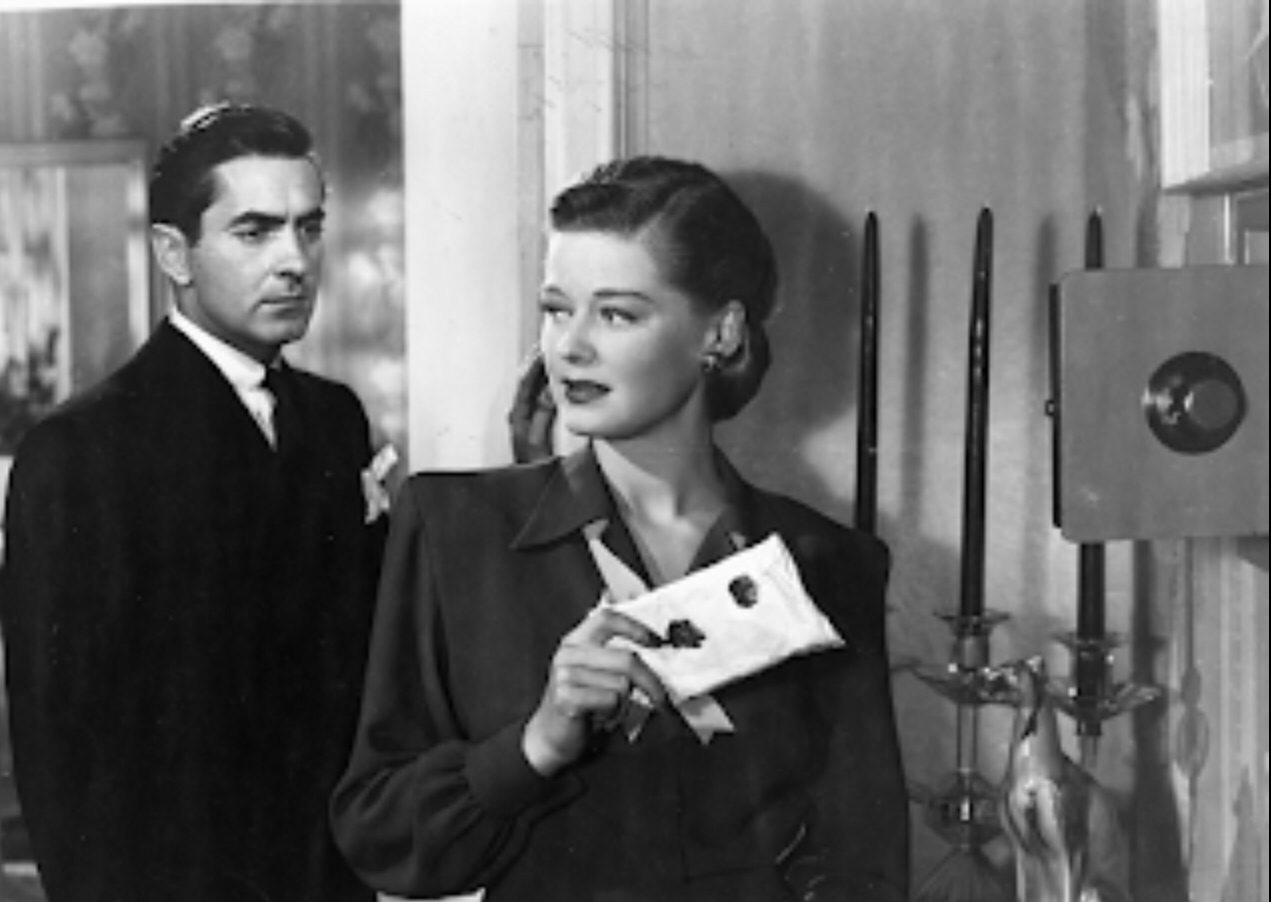 (1947) Stan and Lilith
(1947) Stan and Lilith
In the 1947 version, the final confrontations are darkness and a sense of claustrophobia and how Lilith’s silence, in this powerful scene, cuts like a knife. Subtle to me can be more terrifying and the use of this makes this vital. A more powerful Segway to Stans ending. This version has more appeal to me. (But this is my opinion. Keep that in mind.)
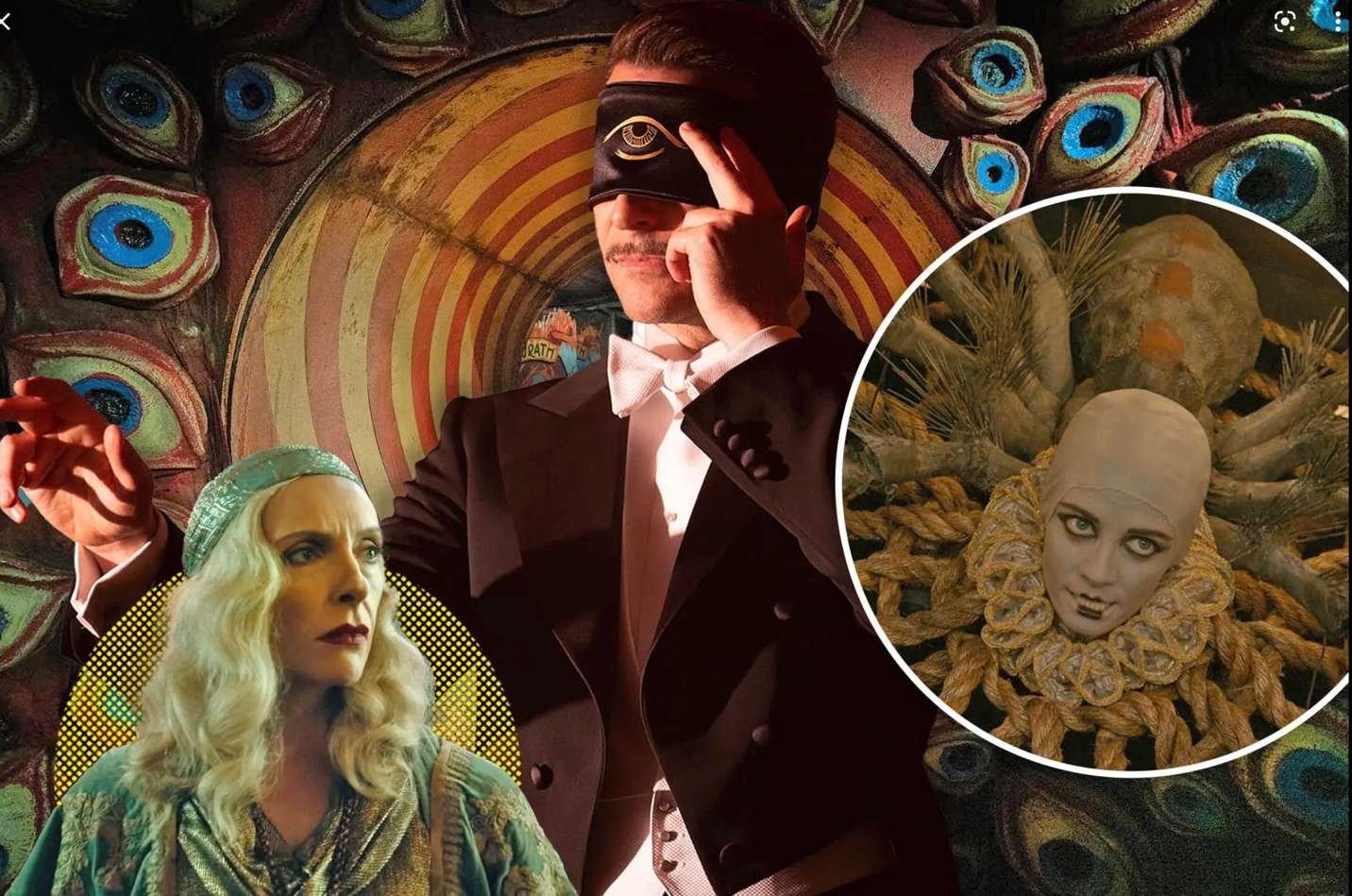
(2021)
This brings us to the final act for Stan. He is back at the carnival. He is a drunk, dirty man. As promised by the Hangman’s card, he has become the most despicable act in the sideshow. The Geek. He is destined to entertain Carnival goers by biting into the necks of live chickens. It’s at this final moment we see the greatest differences between the two versions of the film:
1947 gives a ray of hope from the moment Stan looks at the glass in from of him. For just a moment, you see his hesitation. Both the audience and Stan see the return of Molly, who brings the possibility of redemption for Stan. Maybe she can bring him back and disprove his prophecy of “I was made for this.” Keep in mind, that America was struggling back from WWII. It needed to have hope renewed, that proverbial silver lining. People expected nothing less. And I think that we, the audience, are given maybe not a better ending, but rather the ending we needed more, whether it’s 1947 or 2021.
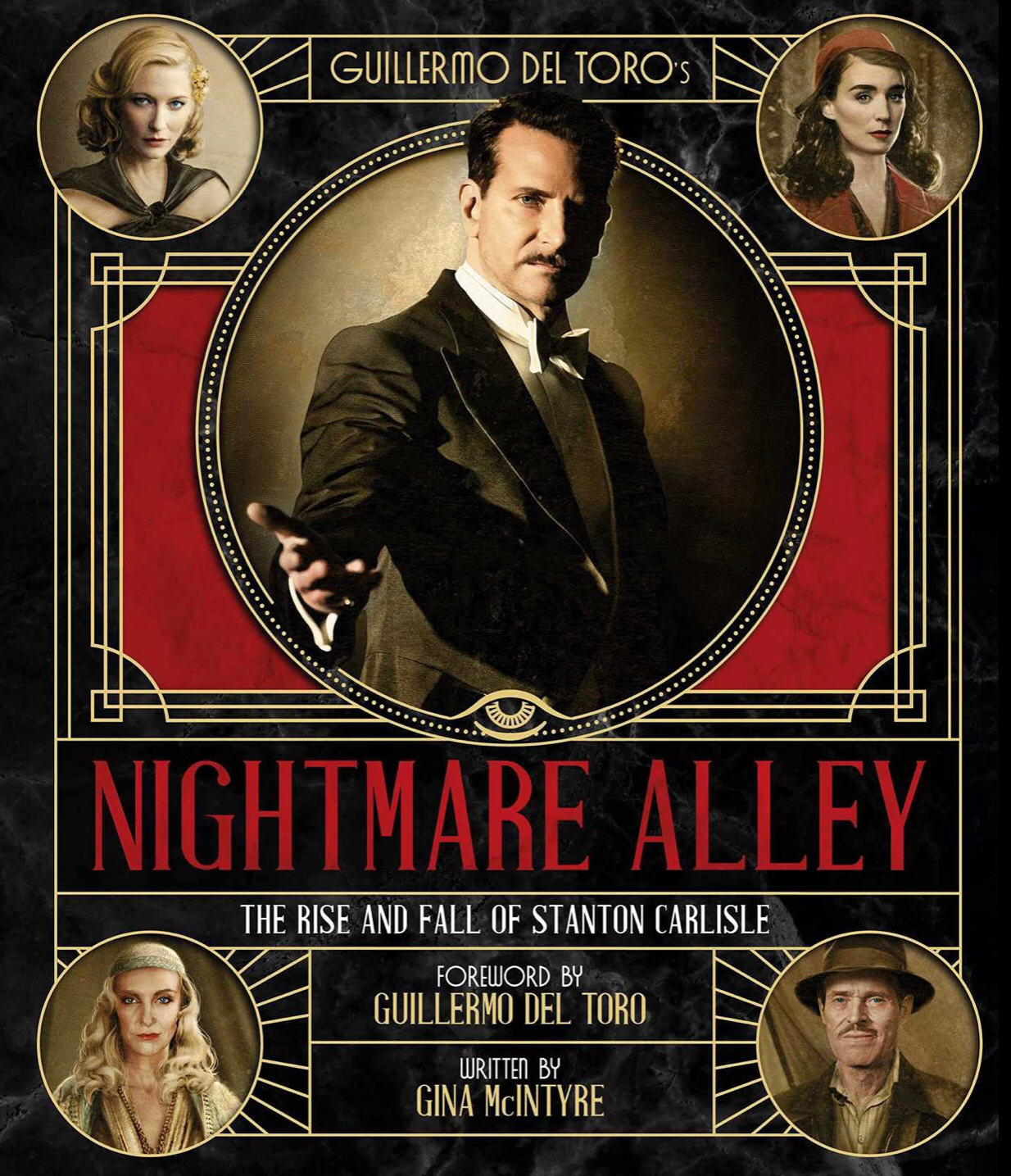
2021 version shows a man without anything. It is powerful and honest. We cannot look away from Bradley Coopers, Stan, as he looks to the glass with glee. There is a sparkle in those beautiful eyes as he gets the irony of his life coming full circle. Maybe that’s why he smiles when he says, “I was born for this!”
I would advise, if you have the chance, to see both versions and judge for yourself which one is your favorite. My personal opinion is that the 1947 version squeaks by with more suspense and terror. It scared me the first time I watched it and the second time was no less terrifying. I found both well made, not to mention I’m a huge fan of Del Toro’s films. It’s my opinion that they both bring something to the table that makes them an excellent horror movie night.
Until next time. I hope you enjoyed the show and the review.
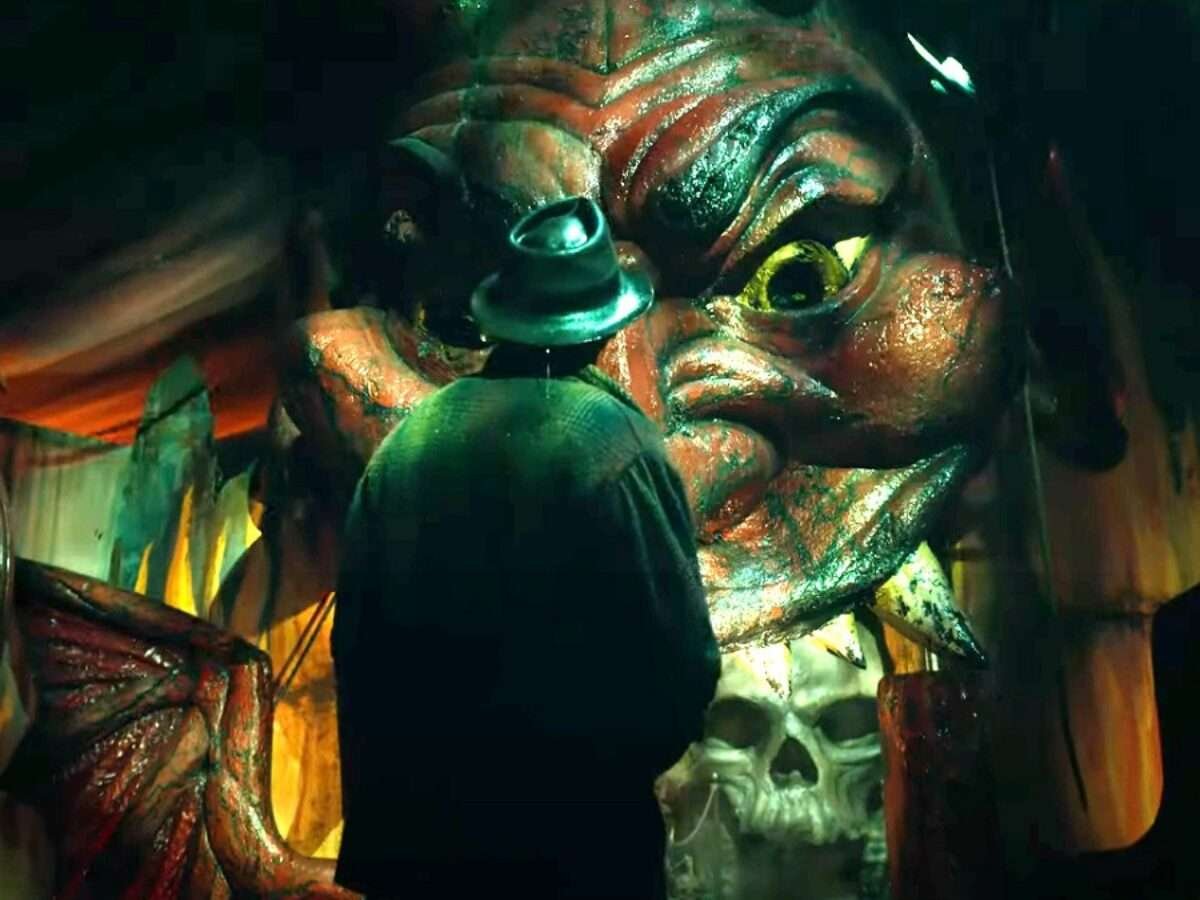
Credits:
Films:
Nightmare Alley (1947)
Nightmare Alley (2021)
Photos:
Wikipedia
Denofgeek.com



